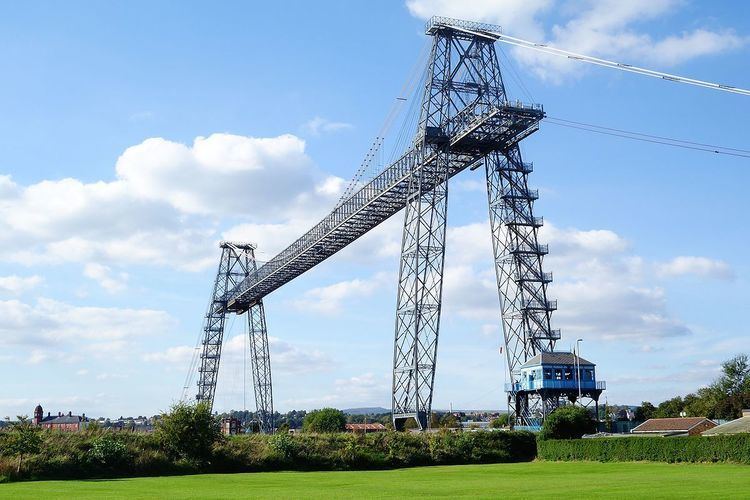Opened 12 September 1906 Construction started 1902 | Locale Newport Height 74 m | |
 | ||
Carries Motor vehicles, cyclists and pedestrians including buses and multi sized lorries. Official name Newport Transporter Bridge Address 64 Cardiff Rd, Newport NP20 2UA, UK Similar Transporter bridge, Tredegar House, Newport Castle, Newport Bridge - Newport, Newport Museum | ||
The weirdest bridge in wales the newport transporter bridge
The Newport Transporter Bridge (Welsh: Pont Gludo Casnewydd) is a transporter bridge that crosses the River Usk in Newport, South East Wales. The bridge is the lowest crossing on the River Usk. It is a Grade I listed structure. The transporter bridge is very rare, with only eight remaining in use out of a total of twenty built worldwide.
Contents
- The weirdest bridge in wales the newport transporter bridge
- Newport transporter bridge
- History
- Reason for the Transporter design
- Principal dimensions
- Other information
- Refurbishment
- Appearances in popular media
- Visitor Centre
- References
Newport transporter bridge
History
The bridge was designed by French engineer Ferdinand Arnodin. It was built in 1906 and opened by Godfrey Charles Morgan, 1st Viscount Tredegar on 12 September 1906.
Newport Museum holds a silver cigar cutter which was presented to Viscount Tredegar on the day of the opening, as a memento of the occasion.
Reason for the Transporter design
The design was chosen because the river banks are very low at the desired crossing point (a few miles south of the city centre) where an ordinary bridge would need a very long approach ramp to attain sufficient height to allow ships to pass under, and a ferry could not be used during low tide at the site.
Principal dimensions
Interestingly for the time, a Corporation Of Newport drawing dated December 1902 is calibrated in metres.
The height of the towers is 73.6 metres (241.5 ft), and the height to the underside of the main girder truss above the road level is 49.97 m (163.9 ft). The span between the centres of the towers is 196.56 m (644.9 ft), and the clearance between the towers is quoted as being 180.44 m (592.0 ft); however, including the cantilevered sections, the main girder truss gives the bridge an overall length of 236 m (774.3 ft). The distance between the centres of the anchorage caissons is 471.06 m (1,545.5 ft). Power to propel the transporter platform or gondola is provided by two 35 hp (26.1 kW) electric motors, which in turn drive a large winch, situated in an elevated winding house at the eastern end of the bridge. This winch is sufficient to drive the gondola through its 196.56 m (644.9 ft) total travel at a speed of 3 metres per second (9.8 ft/s),.
This is the oldest and largest of the three historic transporter bridges which remain in Britain, and also the largest of eight such bridges which remain worldwide).
When compared with Middlesbrough's Transporter Bridge, the Newport Transporter is 5 m (16 ft) taller, but 23 m (75 ft) less in overall length. It also utilizes approximately 1,400 long tons (1,400 tonnes) of steel compared to 2,600 long tons (2,600 t) used to construct Middlesbrough's Transporter (not accounting for steel used in foundations or concrete anchors). This difference in weight is mainly due to the Newport bridge making use of cables to support and induce tension into its structure to a far greater extent than the Middlesbrough bridge.
Other information
Today, the bridge is widely regarded as the most recognisable symbol of the city of Newport.
As well as a working transport link, the bridge is also open as a tourist attraction – visitors can climb the towers and walk across the upper deck for a small charge.
The bridge forms part of the classified highway network and is also where route 4 of the National Cycle Network crosses the River Usk and route 47 begins.
It was the focal point of the local millennium celebrations of 2000, where fireworks were fired from its length, and has been featured in several movies and television shows. It was the centre-piece of the Crow Point Festival in September 2006 to celebrate its centenary. It is used for charity events such as sponsored abseils.
Refurbishment
The bridge was shut down in 1985 because of wear and tear. Following a £3 million refurbishment, it reopened in 1995. Service was suspended again in December 2008 with the bridge facing a £2 million repair bill. £1.225 million was spent on refurbishment, financed by grants from the Welsh Government, Newport Council and Cadw. It re-opened on 30 July 2010.
The bridge was closed on 16 February 2011, because of operational problems, but re-opened again on 4 June.
Appearances in popular media
The transporter bridge provided the setting for some scenes in the 1959 British crime drama film Tiger Bay, which was set in Cardiff and therefore gave audiences the impression that the bridge was in Cardiff and not Newport. The bridge also featured in an early scene in the 1972 experimental film The Other Side of the Underneath by Jane Arden.
Visitor Centre
The Visitor Centre is located on the west bank and features exhibits on the history of the bridge, its construction and other transporter bridges around the world. The centre has a painting of David Pearce, the former undefeated Welsh and British Heavyweight Boxing Champion 1983-1985. David 'Bomber' Pearce used to run up the steps of the Transporter Bridge during his training. The centre is open at weekends.
